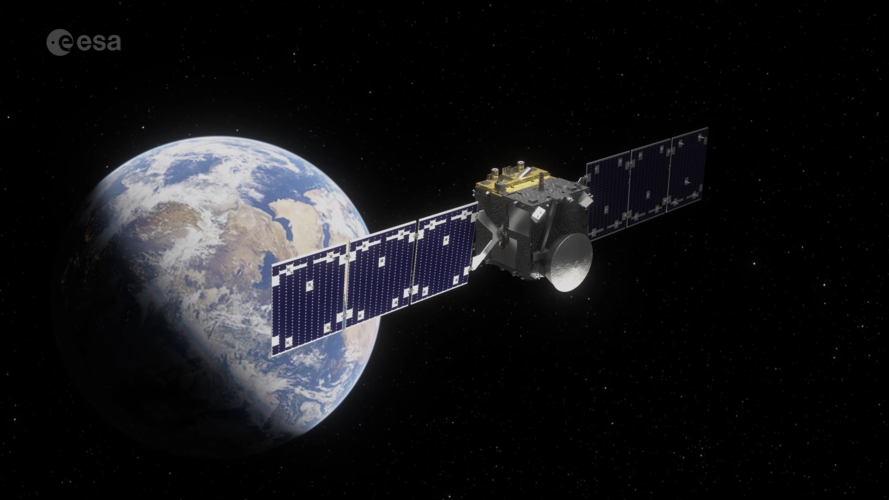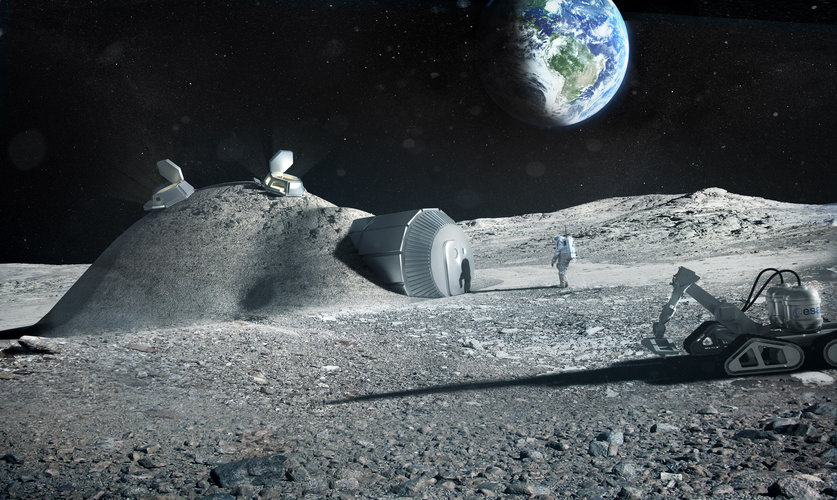Weather may delay launch of mission to study deflected asteroid
Monday, 07 October 2024 10:32Your request has been blocked by our server's security policies.
If you believe this is an error, please contact our support team.
Blue Origin constructs new New Shepard rocket-capsule combo to expand human launches
Monday, 07 October 2024 10:00Your request has been blocked by our server's security policies.
If you believe this is an error, please contact our support team.
Why are we going back to this asteroid?
Monday, 07 October 2024 10:00 Video:
00:11:35
Video:
00:11:35
Hera, ESA’s first planetary defence mission, is headed to space.
Hera will fly to a unique target among the 1.3 million known asteroids of our Solar System – the first body to have had its orbit shifted by human action – to probe lingering unknowns related to its deflection.
Hera is scheduled for launch on a SpaceX Falcon 9 rocket from Cape Canaveral Space Force Station in Florida, USA, today, Monday 7 October, at 16:52 CEST / 15:52 BST.
Using roaches to minimise waste in space
Monday, 07 October 2024 10:00
Waste management is a critical challenge for spaceflight. But what if the waste produced by astronauts could be sustainably transformed into something valuable in space? A Polish company thought about that and has come up an innovative solution: an insect bioreactor powered by Madagascar cockroaches.
NASA's Europa Clipper spacecraft will investigate whether an icy moon of Jupiter can support alien life
Sunday, 06 October 2024 21:00Your request has been blocked by our server's security policies.
If you believe this is an error, please contact our support team.
Critical stress testing completed for Gateway Module
Sunday, 06 October 2024 09:52 NASA's Gateway space station has achieved a key milestone in its development. The Habitation and Logistics Outpost (HALO) module successfully completed static load testing in Turin, Italy, moving it closer to its final preparation for launch into lunar orbit.
This major hardware test marks an important step in Gateway's journey to the Moon, where it will serve both scientific missions and
NASA's Gateway space station has achieved a key milestone in its development. The Habitation and Logistics Outpost (HALO) module successfully completed static load testing in Turin, Italy, moving it closer to its final preparation for launch into lunar orbit.
This major hardware test marks an important step in Gateway's journey to the Moon, where it will serve both scientific missions and Northrop Grumman selected to lead production of hypersonic interceptor
Sunday, 06 October 2024 09:52 The U.S. Missile Defense Agency (MDA) has selected Northrop Grumman Corporation (NYSE: NOC) to advance the development of the Glide Phase Interceptor (GPI), the first defensive countermeasure designed to address the growing threat of hypersonic missiles. This next phase of the program follows a three-year collaboration with MDA that has resulted in an innovative design aimed at neutralizing both
The U.S. Missile Defense Agency (MDA) has selected Northrop Grumman Corporation (NYSE: NOC) to advance the development of the Glide Phase Interceptor (GPI), the first defensive countermeasure designed to address the growing threat of hypersonic missiles. This next phase of the program follows a three-year collaboration with MDA that has resulted in an innovative design aimed at neutralizing both New seismic data unveils detailed view of 9 km asteroid crater beneath Atlantic
Sunday, 06 October 2024 09:52 Researchers from Heriot-Watt University have released new high-resolution images of the Nadir Crater, an asteroid impact site buried deep beneath the Atlantic Ocean. The crater, located about 300 meters below the seafloor, spans approximately 9 kilometers in width and was formed by an asteroid collision around 66 million years ago, at the end of the Cretaceous period.
The Nadir Crater, dis
Researchers from Heriot-Watt University have released new high-resolution images of the Nadir Crater, an asteroid impact site buried deep beneath the Atlantic Ocean. The crater, located about 300 meters below the seafloor, spans approximately 9 kilometers in width and was formed by an asteroid collision around 66 million years ago, at the end of the Cretaceous period.
The Nadir Crater, dis Mercury's magnetic field explored by BepiColombo flyby
Sunday, 06 October 2024 09:52 During its June 2023 flyby of Mercury, ESA's BepiColombo spacecraft gathered critical data on the planet's magnetic field, offering insights into its dynamic magnetosphere. This brief encounter hints at the deeper mysteries BepiColombo will uncover when it enters orbit in 2026.
Mercury, like Earth, has a magnetic field, though it is about 100 times weaker. Despite this, the planet's magnet
During its June 2023 flyby of Mercury, ESA's BepiColombo spacecraft gathered critical data on the planet's magnetic field, offering insights into its dynamic magnetosphere. This brief encounter hints at the deeper mysteries BepiColombo will uncover when it enters orbit in 2026.
Mercury, like Earth, has a magnetic field, though it is about 100 times weaker. Despite this, the planet's magnet Webb uncovers possible evolutionary phase linked to early stars in distant galaxy
Sunday, 06 October 2024 09:52 Peering deep into the universe's past, NASA's James Webb Space Telescope has identified a galaxy with an unusual light signature that could represent an important stage in galactic evolution. The galaxy, GS-NDG-9422, was observed about a billion years after the big bang and may provide clues about the transition between the universe's first stars and more familiar galaxies.
"The first thin
Peering deep into the universe's past, NASA's James Webb Space Telescope has identified a galaxy with an unusual light signature that could represent an important stage in galactic evolution. The galaxy, GS-NDG-9422, was observed about a billion years after the big bang and may provide clues about the transition between the universe's first stars and more familiar galaxies.
"The first thin Mission control GO for Hera launch
Sunday, 06 October 2024 08:00 Image:
Mission control GO for Hera launch
Image:
Mission control GO for Hera launch Parker Solar Probe Completes 21st Close Approach to the Sun
Saturday, 05 October 2024 23:41 NASA's Parker Solar Probe successfully completed its 21st close approach to the Sun on Sept. 30, matching its previous distance record by coming within 7.26 million kilometers (4.51 million miles) of the solar surface. This close approach, known as perihelion, occurred at 5:15 UTC (12:15 a.m. EDT), with the spacecraft traveling at an impressive speed of 635,300 kilometers per hour (394,700 miles
NASA's Parker Solar Probe successfully completed its 21st close approach to the Sun on Sept. 30, matching its previous distance record by coming within 7.26 million kilometers (4.51 million miles) of the solar surface. This close approach, known as perihelion, occurred at 5:15 UTC (12:15 a.m. EDT), with the spacecraft traveling at an impressive speed of 635,300 kilometers per hour (394,700 miles Gold Fields collaborates with Fleet Space's ExoSphere to boost exploration in Chile
Saturday, 05 October 2024 23:41 Fleet Space Technologies, Australia's leading space exploration company, has announced its collaboration with Gold Fields to deploy the ExoSphere solution for advanced mineral exploration at the Salares Norte project in Northern Chile. ExoSphere will provide 3D subsurface imaging of the Brecha Principal and Agua Amarga resource areas, aiming to uncover new insights into the site's mineral system
Fleet Space Technologies, Australia's leading space exploration company, has announced its collaboration with Gold Fields to deploy the ExoSphere solution for advanced mineral exploration at the Salares Norte project in Northern Chile. ExoSphere will provide 3D subsurface imaging of the Brecha Principal and Agua Amarga resource areas, aiming to uncover new insights into the site's mineral system AV boosts stratospheric payload capacity for solar-powered aircraft
Saturday, 05 October 2024 23:41 AeroVironment (AV) recently completed a successful flight test of its updated Sunglider, showcasing advancements in its High-Altitude Platform-Station (HAPS) capabilities for both commercial and government markets. The new version, Horus A, is designed specifically for government applications, offering enhanced stratospheric performance as a solar-powered UAS. It is capable of carrying payloads
AeroVironment (AV) recently completed a successful flight test of its updated Sunglider, showcasing advancements in its High-Altitude Platform-Station (HAPS) capabilities for both commercial and government markets. The new version, Horus A, is designed specifically for government applications, offering enhanced stratospheric performance as a solar-powered UAS. It is capable of carrying payloads 


